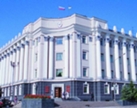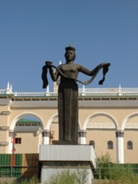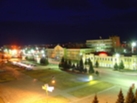   |
Урок английского языка для учащихся 9 класса по теме «Улан-Удэ» Цели урока: 1. Обучающие цели:
2. Развивающие цели:
3. Воспитательные цели:
Оснащение урока: - карта Бурятии; - открытки и фотографии с видами вузов республики, их лабораторий; - тексты с заданиями для учащихся; - презентация «Улан-Удэ». Урок рассчитан на 2 часа. I. Сообщение плана и целей урока II. ULAN-UDE – THE CAPITAL Exercise 1. Read the text. Which sightseeings would you show your foreign friends. Ulan-Ude is the capital of Buryatia. It was founded in 1666 by Russian Cossacks. At present it is a big modern city 220 km east of Irkutsk with 360 000 people living in it. Verkhneudinsk (the old name of the city before 1934) was on the old Silk Road to the east and developed as a trading post in gold, silk and chinaware. There are two rivers in the city: the Selenga and the Uda, which split a multitude of channels to form a number of picturesque green islands. The most famous one is Komsomolsk is -land. There are a lot of picnic places there. The climate is healthy. But sometimes snowstorms complicate the life of the city in winter, particularly the transport and the heating system. Drinking water is good in the city. Ulan-Ude is a cultural centre. It is famous for its theatres. There are 5 higher establishments in the city:
Besides them there are medical and dance schools, creative unions of writers, painters, composers and journalists. There are 3 districts in the city: Sovetsky, Oktyabrsky and Zheleznodorozhny. Sovetsky district has become a business and cultural centre of the city. Zheleznodorozhny is a workers district. And Oktyabrsky is mainly a residential part of Ulan-Ude. Soviet square is one of the finest open places in Ulan-Ude. It is the oldest centre of the city with its Opera and Ballet House, the movie theater "Progress", the building of the central post office and the hotels "Baikal" and "Buryatia". A monument to the soldiers of the Second World War was opened with T-34 preserved as a reminder of the war. The main memorial is a place where newlyweds lay flowers on their wedding day. About 90000 people from Buryatia served in the war and 34 of them received the titel Hero of the Soviet Union. Streets and squares are named after them. Ulan-Ude and its people are hospitable and friendly. Exercise 2. Answer the questions. Suppose your foreign friends have come to the city for the first time.
Ulan-Ude is an important cultural centre of the Republic. It is also a centre of education, isn't it? Prove it. Exercise 3. Say whether the statements are correct.
Exercise 4. Take the pictures of different sights of Ulan-Ude and speak about the city's sights:
Exercise 5. Discuss the answers to these questions with your classmetes.
III. The history of education in Buryatia. 1. Words ancillary – вспомогательный ann ually – ежегодно to cater – стараться доставлять удовольствие, угождать establishment – основание, учреждение graduate – окончить учебное заведение illiteracy – неграмотность to involve – включать nоn-denominational – не относящийся к какому-либо вероисповеданию scope – граница, предел, возможность secular education – мирской, светский 2. Read the text. The first small people's college was opened on February 13, 1793. It marks the beginning of all secular education in Buryatia from schools up to academies and universities. With the establishment of the Soviet power the change of people's education began. In 1931 the single Buryat written language on the basis of the Latin alphabet was introduced, in 1939 it was on the Russian graphical basis. In 1923 there were 12 comprehensive schools with more than two thousand one hundred pupils in the town and by 1925 there had been twenty hundred centers doing away with illiteracy, including eighty six ones which trained in the Buryat language. By 1937 there had been one hundred seventy schools catering for thirty one thousand five hundred forty pupils and twenty five boarding schools for two thousand eight hundred pupils. The education system of Buryatia works according to the continuous scheme: kindergarten – school – technical college – institute of higher education. One hundred and twenty thousand pupils are catered for by six hundred and five schools. The national culture of more than one hundred nationalities and ethnic groups living in the republic has changed the Educational scope of the republic. The majority of national schools have developed programs of involving children into history, language, culture, traditions and customs of their people. There are various types of non-denominational schools: buryat, russian, evenk, Zabaikalien Cossacks, Zabaikalian Old Believers, cross – cultural dialogue “East – West”. New subjects, special courses, optional courses in history and geography of Buryatia, economic basics, world religions history ethnography and rhetoric have been introduced in school programs. New textbooks and ancillary materials on history, culture of the Buryats, Evenks, Zabaikalian Old Believers, nature and ecology of the region, collections of articles on the Russian folk art and traditions of the peoples of Buryatia have been published. Successful work on the improvement of Quality of education provides more opportunities for children to participate in various competitions, olympiads and in international education programs, and through the Internet system. The system of technical vocational education is sixty years old. Ulan-Ude had only two teachers training colleges in 1923 and today there are 16 colleges of further education. The system of primary vocational education consists of 43 educational institutions, including 12 lycees and 24 technical colleges. The total number of students at technical colleges specializing in forty six professions is seventeen thousand one hundred and annually there are eight thousand of highly qualified graduates. 3. Answer the questions. When was the first small people's school opened? When was the Buryat written language introduced? When was it on the Russian graphical basis? Ноw many pupils were there in the republic in 1923? How many comprehensive schools were there in the republic in 1923? What was the scheme of the education system? What subjects were introduced in school programs? What new books were published? IV. State universities in Ulan-Ude Teacher: Next year you leave our school. Where are you going to study? Pupil 1: The system of higher professional education is represented by 4 state and 12 affiliations of state and non-state educational institutions catering for twenty two thousand three hundred students and fifteen thousand two hundred of them are fulltime students. Pupil 2: On May, 1995 the Buryat Agricultural Institute got the status of the Buryat State Agricultural Academy. It is one of the largest educational institutions in the east of our country. In March, 1998 it was named after professor Vasili Rodionovitch Philippov, an outstanding public figure, talented scientist and teacher. Pupil 3: The East-Siberian Institute of culture was founded in 1960 as a Library institute. It was reorganized into the East-Siberian State Academy of Culture and Arts in May, 1995. It is a leading institution of higher education in the country training specialists in the sphere of culture and arts. The task of training professional specialists of culture an arts for the republican national theatres, musical bands and houses of culture is of vital importance in the Academy. It has siyned agreements on training specialists for Yakutiya, Mongolia and Tuva. Pupil 4: The East-Siberian State Technological University, founded in 1962 AS THE East-Siberian State Technological Institute, is the first institution of higher technical education in Zabaikalye. It got the status of the technological university on December 5, 1994 It supplies a lot of branches of the peoples economy with highly qualified specialists in the newest fields of economy and influences the general culture of the population in the Baikal region. Pupil 5: One of the oldest institutions of higher education was the Pedagogical Institute after Dorzhi Banzarov, the first Buryat scientist. It was founded in 1932 and for many years it had been the main “smithy” of teachers in the whole region. The Buryat State University was established by the union of the Buryat Pedagogical Institute after Dorzhi Banzarov and the Buryat branch of Novosibirsk State University by the Decret of the President of the Russian Federation. It is one of the largest scientific and cultural centers of Siberia. Answer the questions: What university would you like to enter? Why? V. Dorzhi Banzarov, the first Buryat scientist 1. Translate the words: to appeal – обращаться, взывать, привлекать belief – вера, убеждение to devote – посвящать exemption – освобождение oriental – восточный patron – святой to relegate – отсылать, предавать забвению, высылать spirit – дух 2. Listen to the text: Dorzhi Banzarov was born in March 1822 in a Buryat village not far from Dzhida. His father was a Cossack. When Dorzhi was ten years old, he began to study at the Russian – Mongolian military school in Kyakhta. This school was the best cultural centre in Buryatia of the 19th century. He did well at school and left it after three years. Dorzhi had high grades in Russian and Mongolian grammar, arithmetic and other subjects. In 1835 he entered the Kazan gy mnasium with three other Buryat boys. At the gymnasium they studied Russian grammar, mathematics, history, geography, latin, frrench, english and turkish and other subjects. Other subjects. In 1842 he graduated it with a gold medal and entered Kazan University. He liked philosophy, history and oriental and European languages. D. Banzarov graduated from the University in 1846 with a philosophy doctor degree for his famous work “Black Belief or Shamanism of the Mongols”. At that time he decided to devote himself to science, but he couldn't do it because he had to do his 25 years in Cossack service. In 1847 he went to St. Petersburg to make an appeal for his exemption from Cossack service. The government didn't permit to do so; instead they relegated him to Irkutsk. Nevertheless, that period of his life was the best for studying in the Asian Museum of the Academy of Science and for making friends with the capital's scientists. He was a very kind and clever man and people loved and respected him very much. His famous book “Black Belief or Shamanism of the Mongols” was about the obo (a small hill of ground and stones) and about the spirits and patrons of the country. In his article the “White Month” (1846) he wrote about the tradition of celebrating Sagaalgan. He died in 1855 in Irkutsk when he was only 33 years old. He made a major contribution to our science. The Buryat nation is proud of its scientists. Nowadays the Buryat University is named after D. Banzarov, the first Buryat scientist. Exercises: 1. Number the sentences 1 through 8 to show the correct order: a) In 1835 he entered the Kazan gymnasium. b) He liked philosophy, history and oriental and European languages. c) D. Banzarov was born in March 1822. d) He died in Irkutsk when he was only 33 years old. e) When Dorzhi was 10 years old, he began to study. f) In 1842 he graduated with a gold medal. g) He did well at school. h) In 1847 he went to St. Petersburg. 2. Discuss the answers to these questions with your classmates: Are you proud of the famous people of Buryatia? Why? VI. Towns of Buryatia Do you like travelling? What towns of the republic have you visited? 1. Read the information about the other towns of Buryatia: Gusinoozyorsk is the second largest industrial centre in Buryatia. It`s situated on the north-eastern shores of Gusinoye (geese lake), 110 km from Ulan-Ude. First of all, it is the main coal-mining centre of the republic. The Gusinoozyorsk state thermal power station is being built now (it`s under construction). Kyakhta is an ancient town on the Russian-Mongolian border in the south of the republic. It`s old name is Troitskosavsk, it was renamed in 1934. It was founded in 1728 as in important trading centre between Russia and China. Today Kyakhta is an industrial town. There is a local History museum, which boasts of lots of historic and archeological finds. The academician V.A. Obruchev founded it in 1890. Babyshkin – the old name of the town is Mysovsk – is situated on the southern shore of Baikal. The town`s name speaks of its history. It was named after Ivan Babyshkin, who was murdered in January 1906 at the railway station of Mysovaya. It is another industrial area in the republic, one of the biggest railway stations Zakamensk is a town in the southwest of the republic. It is situated in the mountainous part of the republic, so the locality is rich in mineral recourses. Near Zakamensk there are the richest deposits of tungsten in the republic. The dzhida wolfram enterprise is situated there. It`s the largest one in east Siberia. The Dzhida enterprise supplies many of the country`s metallurgical works with its product. There is also food productions. Severobaikalsk is situated on the river Verkhnya Angara. There are many nationalities in the town as a result of the building of the famous Baikal-Amur Railway. Many people came as volunteers to build it. Severobaikalsk is one of the modern towns of Eastern Siberia. 2. Do you know the towns of Buryatia ?
3.Discuss the answers to these questions with your classmates. 1. What streets, villages and towns do you know that were named after somebody? 2. What have you learnt about the industrial centres of the republic of Buryatia? 3. What should be done to protect nature? 4. Do you know why it was necessary to build the Trans-Siberian Railway near Baikal? V. Conclusion Dear students, thank you for your good work. You have good and excellent marks. Good bye!
|
|
|
|
© ir-bazarova2011 |
